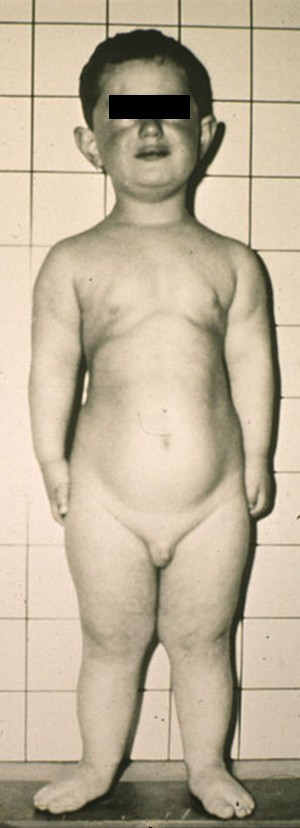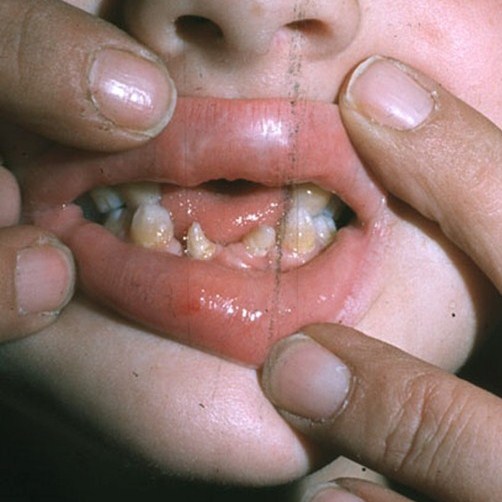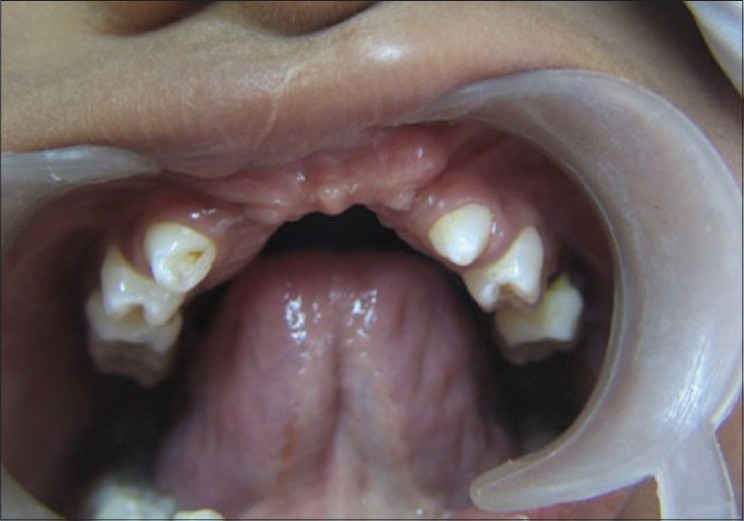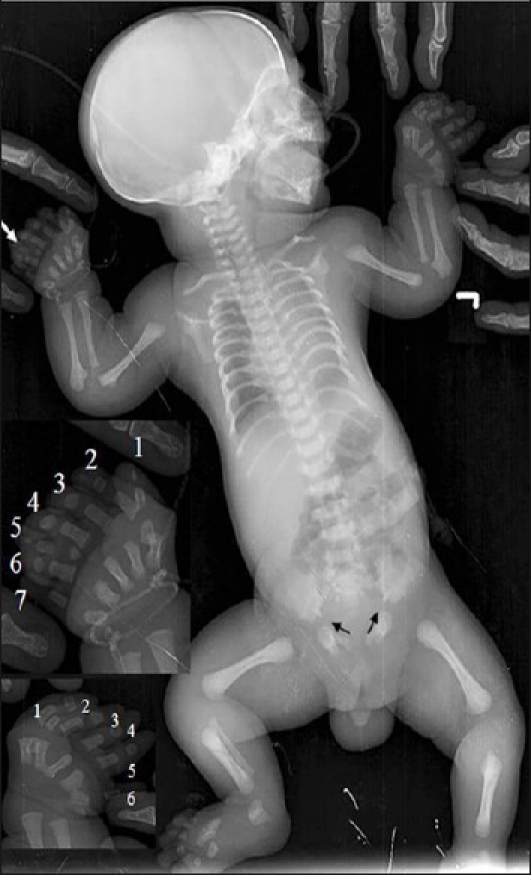Ellis-van Creveld syndrome (EvC)
Ellis-van Creveld syndrome (EvC syndrome) is a member of a group of conditions called short rib-polydactyly syndromes. These conditions are characterized by specific types of bone malformations. Patients typically have a narrow thorax (chest) and extra fingers and/or toes (polydactyly). Other members of this group include Jeune syndrome (aka JATD) and a number of disorders collectively called short rib-polydactyly syndrome. There are 4 types of this syndrome, all of which are generally lethal in the prenatal period. They are: Saldino-Noonan syndrome (type 1), Majewski syndrome (type 2), Verma-Naumoff syndrome (type 3) and Beemer-Langer syndrome (Type 4). These syndromes are clinically heterogeneous, but affected individuals often have visceral malformations (though malformations differ between the syndromes).
Clinical information
Ellis van Creveld (EvC) syndrome, also known as chondroectodermal dysplasia, is characterized by abnormalities in the skeleton. These abnormalities include short arms and legs, extra fingers and/or toes, and a narrow chest (see photos). Roughly 60% of patients have heart defects, which may include atrial and ventricular septal defects (abnormal openings in the walls between heart chambers). Some patients also have cardiomegaly (an enlarged heart) and patent ductus arteriosis (PDA). The ductus arteriosis is a blood vessel that normally closes within a few days of birth; in PDA, it remains open. In some people with PDA, the condition is not serious, but in others, it can weaken the heart and must be treated with medications or surgery.
EvC syndrome patients often have many of the following medical problems:
- Polydacytly (extra fingers and/or toes)
- Syndacytly (joined fingers and/or toes)
- Very short stature, with abnormally short legs and arms (trunk is normally sized)
- Abnormally shaped teeth (cone-shaped, for example)
- Very small teeth
- Hypodontia/too few teeth
- Maloccluded (crooked) teeth
- Many dental cavities
- Multiple frenulae (tissues attaching the mouth to the gums)
- Fingernail and toenail abnormalities
- Short fingers
- Genu valgum (knock knees)
- Narrow chest
- Abnormal curvature of the spine
- Cardiac abnormalities
- Fusion of the hamate and capitate bones of the hand
Intelligence in EvC is usually normal, though it is affected in a small percentage of cases (~10-15% by our estimates based on the literature). EvC is also a very rare disease, occuring in an estimated 1 in 60,000 to 200,000 newborns (1). It is more common among people of Arab and Amish descent. In the Amish, incidence in newborns appears to be much higher than in most other population groups (2).
Diagnosis and Testing
EvC syndrome is an autosomal recessive disease caused by mutations in the genes EVC or EVC2. EVC2 is also called LBN. The term autosomal recessive means that the syndrome is passed on when both parents contribute a copy of the mutated gene to their child. Mutations in the genes EVC or EVC2 account for more than half of all known cases of Ellis-van Creveld syndrome. Researchers do not know what causes the other cases.
EvC syndrome is often diagnosed clinically, because the combination of polydactyly, disproportionate short stature, and dental and cardiac abnormalities are highly suggestive of this syndrome. In recent years, the proliferation of genetic testing has improved accuracy of diagnosis in general. Testing tries to identify mutations in the genes mentioned in the previous paragraph. If you are not a doctor and suspect that your child has EvC syndrome, check with your family physician, who will compare your child's signs and symptoms with those known to occur in this syndrome. Your doctor can obtain a sample from your child and send it to a testing center. The US National Institutes of Health maintains a list of laboratories that do testing (see link at right).
An excellent review of this syndrome was published in 2007 (3).
Differential Diagnosis
Weyers acrofacial dysostosis (WAD) is allelic with EvC syndrome. Allelic conditions are caused by mutations in the same gene. WAD is very similar to Evc syndrome, but it is generally milder. Like EvC syndrome, WAD affects the teeth, nails, and bones. Dental abnormalities include the same types of problems found in EvC (small teeth that may be conical and fewer teeth than normal). WAD patients tend to be short, but not as short as EvC syndrome patients, and they are not disproportionately short (short legs and arms with normal trunk). WAD patients also have nail dysplasia (small or misformed fingernails or toenails). They may also have extra fingers and/or toes. Congenital heart defects are not a feature of WAD, nor is thoracic dysplasia (3); the presence or absence of these problems may help discriminate between the two conditions. It is possible that WAD and EvC syndrome represent different severity groups of the same condition.
In contrast to EvC syndrome being an autosomal recessive disorder, WAD is autosomal dominant. This term means that only one copy of a mutated gene is enough to cause the disorder. Many autosomal dominant disorders are inherited from a parent who has the disease. Others occur when a mutation arises spontaneously. Thus, a family history of the symptoms described here may also help discriminate between EvC syndrome and WAD. In addition, EvC syndrome results from a loss-of-function mutation in EVC or EVC2. WAD patients have a truncated protein that presumably has some function, which results in the milder phenotype.
Jeune Asphyxiating Thoracic Dystrophy (also Jeune syndrome or JS) is the other non-lethal short rib-polydactyly syndrome. In general, Jeune syndrome patients tend to be taller than people with EvC syndrome. Most importantly, they lack the dental and congenital cardiac defects that are very common in EvC syndrome. Polydactyly is rare in Jeune syndrome, but it does occur in a minority of patients (15-20%).
EvC syndrome should also be distinguished from McKusick-Kaufman (MKK or MKS) syndrome. Individuals with this syndrome have congenital heart defects and polydacytly. Unlike EvC patients, females with MKK syndrome frequently have hydrometrocolpos, or abnormalities of the vagina or uterus. Specifically, in infants, the vagina and uterus become dilatated when cervical secretions accumulate. This problem may occur because a part of the vagina did not develop or because a membrane blocks the exit of the secretions (4). Males have genital malformations including hypospadias (the urethra does not exit at the tip of the penis), cryptorchidism (undescended testicles), and chordee (abnormal curvature of the penis). MKK syndrome patients do not have disproportionate short statue observed in EvC syndrome, although they may have short stature. MKK syndrome is caused by mutations in the gene MKKS.
The bodies of persons with EvC syndrome may resemble the bodies of people with achondroplasia (see photo at top right). However, the constellation of other problems in EvC syndrome are not present as a group in achondroplasia.
References
- 1. Source: Genetics Home Reference entry on Ellis-van Creveld syndrome. Full text.
- 2. McKusick VA (2000) Ellis-van Creveld syndrome and the Amish. Nat Genet. 24(3):203-204. Abstract on Pubmed.
- 3. Baujat G & Le Merrer M (2007) Ellis-Van Creveld syndrome. Orphanet Journal of Rare Diseases 2:27. Full text on PubMed.
- 4. Slavotinek AM (2002) McKusick-Kaufman Syndrome. (Updated June 4, 2015). GeneReviews [Internet] Pagon RA et al., editors. Seattle (WA): University of Washington, Seattle; 1993-2021. Full text.
- 5. Bhat YJ et al. (2010) Ellis-van Creveld syndrome with facial hemiatrophy. Ind J Derm Ven Lepr 76(3):266-269. Full text from publisher.
- 6. Babaji P (2010) Oral abnormalities in the Ellis-van Creveld syndrome. Ind J Dent Res 21(1):143-145. Full text from publisher.
- 7. Kundaragi NG et al. (2011) Ellis van creveld syndrome with synpolydactyly, an antenatal diagnosis with postnatal correlation. J Clin Imaging Sci 1:59. doi: 10.4103/2156-7514.91132 Full text on PubMed.





